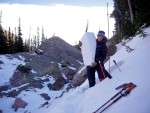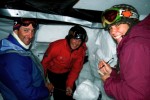Trees killed by beetles affect snowmelt dynamics, and effects of snowmelt on downstream nitrate concentrations can be strong, according to two recent publications by Danielle Perrot and co-authors. Perrot, who received her Master of Arts in Geography and Graduate Certificate in Hydrologic Sciences from the University of Colorado-Boulder in 2012, began the beetle-kill study as an undergraduate at the University of California-Los Angeles, and began the stream nitrate study as a graduate student associated with the Niwot Ridge (NWT) Long Term Ecological Research (LTER) in Colorado.
"Growing up in California, I've always been hyper-sensitive to topics in water resources, and I was fascinated by the idea that forest health could affect snowmelt and hence water resources and forest management," Perrot said. "I was curious about trying to model how tree canopies interact with the snowpack, and what would happen according to the model if you changed the canopy structure."
Perrot found that tree color was related to snowmelt in an interesting way. "Trees killed by the mountain pine beetle turn a sort of red as dead needles lose their green color and begin to drop, and they look grey after all the needles are gone," Perrot said. To compare snowmelt dynamics under green-, red- and grey-phase trees, Perrot compared snowmelt scenarios using a model of the energy budget for a column of snow. The energy available for melting snow depends in part on external temperature, incoming radiation and the albedo of the snow surface. Albedo is the proportion of incident short-wave radiation reflected away from the surface and therefore not available to melt the snow. Perrot explored the model using data from snow columns sampled along transects between trees in green, red and grey phases.
"Albedo was the dominant factor controlling snowmelt," said Perrot, "and snow under red-phase trees melted faster because of the lower reflectance of needles dropped onto the snow surface." Snow accumulation was highest under bare trees in the grey phase, Perrot said, and incident radiation was lower under the shade of both green- and red-phase canopies, but the lower albedo of the needle-strewn snows under red-phase trees caused a period of increased snowmelt following a pine-beetle infestation. Perrot conducted the research as an undergraduate working with Noah Molotch, Assistant Professor of Geography at the University of Colorado-Boulder, who also co-authored the paper, published in Ecohydrology in April 2014.
Continuing as a graduate student in the Molotch lab, Perrot shifted her focus to the consequences of variation in snowmelt on downstream nitrate concentrations. Using data from the Tokopah Basin in California and Green Lakes Valley in Colorado, Perrot and colleagues modeled observed stream nitrate concentrations as a function of pulses in the volume of snowmelt distributed across each basin. .
"We found a significant and strong relationship between snowmelt and stream nitrate concentration in our California basin, but not in Green Lakes Valley," said Perrot, "which parallels previous results showing stronger coupling between snowmelt and streamflow in the California site.” Perrot said the Green Lakes Valley may be more strongly influenced by deeper flowpaths below the surface between the snowpack and the stream. “The difference between these results should help us understand the variation in how basins will respond hydrochemically to changes in climate," she noted.The results of the study were published online in Water Resources Research on November 12, 2014.
Perrot counts her experiences in modeling snowmelt as excellent preparation for her job as Water Resources Analyst for the City of Greeley, Colorado. "Although now I work on the operational side of water resources, I gained valuable analytical and computational skills from doing academic research. I learned to use a methodological framework for answering questions that I apply every day within my current position. Scientific research has taught me how to use logic and creativity together to problem-solve."
Some of the outstanding questions arising from Perrot's research include how snowmelt-nitrate dynamics might respond to future climates and how snow-surface albedo is altered by pulses of needle litter. "As needles are deposited to the snow surface during storms or high-wind events, they can become buried in the snowpack in distinct layers as snow accumulates. It would be interesting to model snowmelt for a snowpack with one or several persistent needle layers. The albedo would change drastically as these needle layers are exposed to sunlight at the surface, causing temporal variation in snowmelt rates." Perrot will leave it to another student to model the potential linkage between effects of beetle-kill on snowmelt, and snowmelt on downstream nitrate concentrations.
Publications referenced
Published in print April 2014; published online 2012: Danielle Perrot, Noah P. Molotch, Musselman, K. N., Pugh, E., 2014: Modeling the effects of the Mountain Pine Beetle on snowmelt in a subalpine forest. Ecohydrology, 7(2), 226 – 241. DOI: 10.1002/eco.1329
Published online November 2014: Danielle Perrot, Noah P. Molotch, Mark Williams, Sickman, J. O., 2014: Relationships between stream nitrate concentration and spatially distributed snowmelt in high elevation catchments of the western U.S.. Water Resources Research, accepted. DOI: 10.1002/2013WR015243
Causes and consequences of snowmelt dynamics
By:
Chris Ray (NWT) 
 Enlarge this image
Enlarge this image
